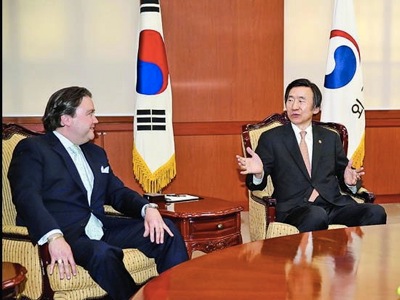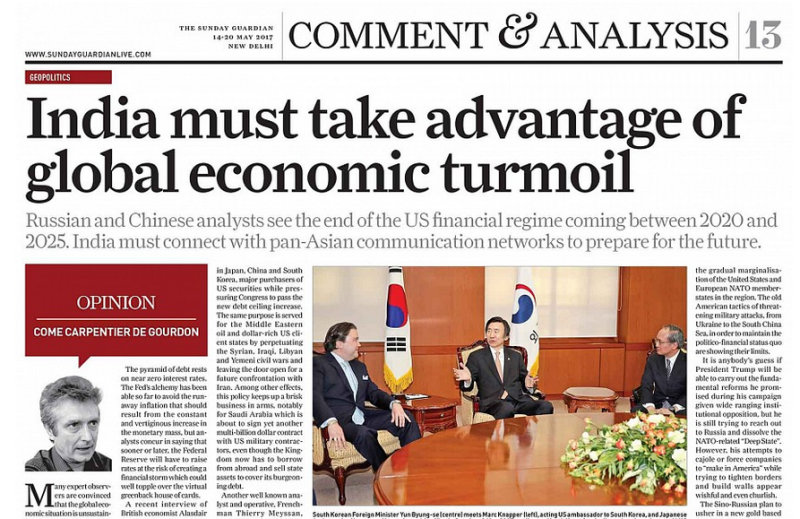Russian and Chinese analysts see the end of the US financial regime coming between 2020 and 2025. India must connect with pan-Asian communication networks to prepare for the future.

Many expert observers are convinced that the global economic situation is unsustainable and heading towards a debacle. The USA is mired in ever rising public debt, soon to reach 100% of its GDP and compounded with even larger private debt. Worldwide, the debt level is above 250 trillion and the amounts of derivatives and other hazardous financial products misleadingly called “securities” far exceeds the quadrillion figure (a thousand trillion). Most of that virtual money is denominated in US dollars which are backed by the full faith and credit of the American Treasury, and nothing else. Yet, Washington is unable to balance its budgets and recurrently steps on the brink of government shutdown which can only be averted each time by a new rise of the debt ceiling, while on the other hand major American companies are stockpiling colossal reserves in offshore jurisdictions in order to evade domestic taxes on corporate earnings.
The pyramid of debt rests on near zero interest rates. The Fed’s alchemy has been able so far to avoid the runaway inflation that should result from the constant and vertiginous increase in the monetary mass, but analysts concur in saying that sooner or later, the Federal Reserve will have to raise rates at the risk of creating a financial storm which could well topple over the virtual greenback house of cards.
A recent interview of British economist Alasdair McLeod [1] featured his comments on the analysis conducted by Chinese military strategist General Zhao Liang in a 1999 book Unrestricted Warfare [2]. The General expressed the tacit Chinese official view that the US has so far been able to ride a tsunami of debt by using its fiat dollars backed by political/military clout to suck out real wealth from many other countries. Those assets, such as oil, minerals, real estate and consumer goods are paid for in freely created dollars and when need be, political and military crises are engineered or pumped up to generate a climate of uncertainty which in turn increases the demand for dollars as a refuge currency.
According to McLeod, the present ratcheting of tension with North Korea was triggered by the Trump administration to create fear in Japan, China and South Korea, major purchasers of US securities while pressuring Congress to pass the new debt ceiling increase. The same purpose is served for the Middle Eastern oil and dollar-rich US client states by perpetuating the Syrian, Iraqi, Libyan and Yemeni civil wars and leaving the door open for a future confrontation with Iran. Among other effects, this policy keeps up a brisk business in arms, notably for Saudi Arabia which is about to sign yet another multi-billion dollar contract with US military contractors, even though the Kingdom now has to borrow from abroad and sell state assets to cover its burgeoning debt.
Another well known analyst and operative, Frenchman Thierry Meyssan, provides a convergent perspective from a different angle in his latest book Sous Nos Yeux (Right Before Our Eyes, Réseau Voltaire 2017 [3]). He exposes, citing public and leaked documents the long-term British and American strategy of using the Muslim Brotherhood, at least since the 1950s, and its diverse affiliates and offshoots, from North Africa to South East and Central Asia as part of the strategy of tension directed against “problematic” states and also against the European Union, now confronted with an acute and long-term refugee and terror crisis. The primary alliance is with Saudi Arabia, the mother lode of Wahhabism and one of the largest holders of US dollars, but in other countries, Islamist radical movements have been weaponised, since the days of the Soviet intrusion into Afghanistan, against a variety of strategic rivals and enemies.
This state of affairs affects India directly in Kashmir where Meyssan forecasts rising turmoil due to the predictable migration of Jihadi fighters from Syria, Chechnya, Iraq, Yemen and Afghanistan towards the subcontinent.
Meyssan’s account of the Libyan civil war which he saw from inside—as he was an adviser to Gaddafi’s government at the time—is particularly enlightening. He describes the secret diplomatic games between the US, European states and other nations, aimed at taking over the 150 billion dollars in reserves held by the Libyan regime and points out that this treasury has now disappeared. He accuses NATO of having seized up to one third of that booty. During the western (and Qatar) backed rebellion in Libya, some EU governments tried to come to a deal with the beleaguered Gaddafi, alleged to have partly funded the 2008 French presidential campaigns of both candidates, Nicolas Sarkozy and Segolene Royal; only to be blocked by the Americans who were, as Obama intended, “leading from behind” the European states to unseat the Libyan “Supreme Guide” and put in his place their Muslim Brotherhood allies.
Meyssan is now in Syria and he records that many of the Islamic fighters and weapons were subsequently sent from Libya to Syria with the agreement of the US government in order to expand the uprising over there. The plan was to help set up a Muslim Brotherhood controlled government in Damascus as in Cairo even though Saudi Arabia did not agree and, adding to the confusion and divisions, had her own Salafist candidates to take power in both countries.
The Libyan drama, rooted in Gaddafi’s plan to launch a gold based pan-African currency, meant to replace both the dollar and the CFA franc, was an object lesson for China and Russia, but did not change their intention to establish a new international currency backed by gold for the Euro-Asian economic space in which Beijing’s One Belt One Road and Moscow’s RAZVITIE Corridor of Development are to be major arteries. This area already boasts a 50 trillion GDP in dollars compared to the US’s 18 trillion and new fast rail and road links between China and western Europe are redrawing the maps of world trade.
The tendency towards regional cooperation is made manifest by the ongoing rapprochement between Russia and Japan, Tokyo’s decision to join the China-led Asian Infrastructure Investment Bank, the growing convergence between most ASEAN states and China and the election on 9 May of a new South Korean President committed to détente and perhaps reunification with the North and to better coordination of policies with Beijing in a clear sign of distrust of the United States.
In the Middle East, the agreements being hammered out between Russia, Iran and Turkey for ending the war in Syria and crushing ISIS and NATO-backed Islamist militias with Iraq’s concurrence and despite Saudi reluctance evinces the gradual marginalisation of the United States and European NATO member-states in the region. The old American tactics of threatening military attacks, from Ukraine to the South China Sea, in order to maintain the politico-financial status quo are showing their limits.
It is anybody’s guess if President Trump will be able to carry out the fundamental reforms he promised during his campaign given wide ranging institutional opposition, but he is still trying to reach out to Russia and dissolve the NATO-related “Deep State”. However, his attempts to cajole or force companies to “make in America” while trying to tighten borders and build walls appear wishful and even churlish.
The Sino-Russian plan to usher in a new gold based currency for strategic commodities has been delayed to avoid an all out international conflict but the Shanghai Gold Exchange, now the world’s largest, shows the way. Both Russian and Chinese analysts see the end of the US financial regime coming between 2020 and 2025 if not earlier and prepare to bring about the new system by then.
India must take advantage of the emerging global economic and commercial architecture and connect with the pan-Asian communication and transport networks. The Indian Ocean Regional Forum is a logical counterpart of ASEAN, the Shanghai Cooperation Organisation and the Eurasian Economic Union. In the days of yore, the Silk Routes were linked with the Cotton Highways. The past presents India with its future.
[1] “China to Price Energy in Gold, Displace Dollar”, Alasdair MacLeod, Guadalajara Geopolitics Institute in Podcast, May 5th, 2017.
[2] Unrestricted Warfare: China’s Master Plan to Destroy America, colonel Qiao Liang & colonel Wang Xiangsui, PLA Literature and Arts Publishing House, 1999.
[3] Sous nos yeux. Du 11-Septembre à Donald Trump, Thierry Meyssan, éditions Demi-Lune, 20017.


 Articles by this author
Articles by this author










Stay In Touch
Follow us on social networks
Subscribe to weekly newsletter